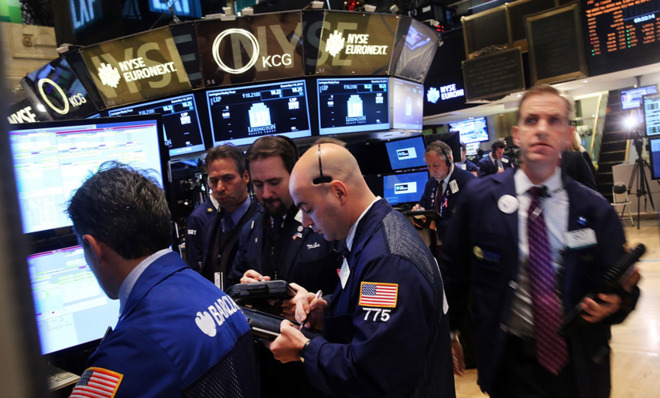The perils of predicting a stock market crash in 2014
The only bubble we're in appears to be filled with hot air

In the world of Wall Street crystal-ball-gazing, you can always count on a bearish faction to predict the worst. But Paul B. Farrell, a columnist at Marketwatch, might have gotten a little carried away this week, warning that there is a 98 percent chance of a stock market crash in 2014.
First things first: I have no idea where he got that 98 percent figure. Based on his article, it does not appear to be the product of any analytical model. Claiming a 98 percent probability just seems to be a quick way to express the idea that a crash is extremely likely.
This isn't the first time he’s made such a prediction. This June, Farrell theorized that there was an 87 percent probability of a stock market crash in 2013, a prediction that is quickly running out of time.
The Week
Escape your echo chamber. Get the facts behind the news, plus analysis from multiple perspectives.

Sign up for The Week's Free Newsletters
From our morning news briefing to a weekly Good News Newsletter, get the best of The Week delivered directly to your inbox.
From our morning news briefing to a weekly Good News Newsletter, get the best of The Week delivered directly to your inbox.
He theorized that the financial apocalypse is nigh because we are in a huge economic bubble — the Bubble With No Name — caused by the Federal Reserve keeping interest rates too low.
Yes, interest rates have been very low for a long time. But that's not solely because of the rate targets set by the central bank. Interest rates, after all, are simply the price of credit. If you combine a weak economy with high unemployment and low demand for credit, then interest rates are going to be low whatever the Fed does. In the Great Depression, for example, interest rates were simillarly low, even without a massive monetary intervention.
Plus, having low interest rates is not really a bad thing, because it means that spare capacity can be deployed more cheaply. It means that the unemployment rate can be reduced, and businesses, individuals, and governments can invest in productive activities cheaply. If we’re going to have a sustainable recovery, low interest rates are a path to get there.
And guess what? Since Farrell made his doomsday predictions in June 2013 — and while he was writing more articles with titles like "America’s new ‘economic guillotine’ is dead ahead" — the economy made some substantial progress, with unemployment falling quickly and growth picking up strongly. Low interest rates aren’t dooming America — they’re helping America recover.
A free daily email with the biggest news stories of the day – and the best features from TheWeek.com
Now, I don’t know if there will be a crash in 2014 or not. I don’t think anyone really does. Trying to predict markets involves understanding human psychology, and humans are not always rational and certainly not mechanistic. The number of variables at work in the stock market are dizzying.
There are plenty of risk factors for 2014. Weakening demand from China due to a Chinese real estate or financial slump is a possibility. The Federal Reserve tapering its asset purchase programs also probably poses a risk to markets’ upward trend. And there are the usual geopolitical risks: Natural disasters, conflict in the Middle East, etc.
But there are also plenty of causes for optimism, too. A premature taper of the Fed’s asset-buying programs is beginning to look significantly less likely with the appointment of Janet Yellen, who is seemingly determined to lower unemployment further, and has scope to do so with inflation still a whole percentage point below the central bank’s target. And Congress is on the verge of passing a budget deal, suggesting that the days of uncertainty resulting from congressional dysfunction may finally be over!
Energy prices are moving lower as American domestic oil production ramps up; indeed, the U.S. is on trend to become the largest oil producer in the world. After years in the dumps, real estate prices are finally improving, meaning that one big drag on the economy is being lifted. Credit is expanding to both businesses and households. And growth remains reasonably high around the world, suggesting that global demand for American goods and services will remain decent.
There is plenty of reason to believe that the recovery will strengthen, growth will continue to climb, and unemployment will continue to fall. Obviously, nobody knows the future so we can’t be sure. But those who keep predicting imminent doom and disaster keep getting more egg on their faces. Perhaps the real unsustainable bubble is in claiming that there is a huge unsustainable bubble.
John Aziz is the economics and business correspondent at TheWeek.com. He is also an associate editor at Pieria.co.uk. Previously his work has appeared on Business Insider, Zero Hedge, and Noahpinion.
-
 A lemon-shaped exoplanet is squeezing what we know about planet formation
A lemon-shaped exoplanet is squeezing what we know about planet formationUnder the radar It may be made from a former star
-
 Political cartoons for January 4
Political cartoons for January 4Cartoons Sunday's political cartoons include a resolution to learn a new language, and new names in Hades and on battleships
-
 The ultimate films of 2025 by genre
The ultimate films of 2025 by genreThe Week Recommends From comedies to thrillers, documentaries to animations, 2025 featured some unforgettable film moments